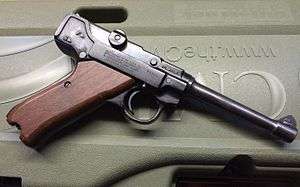Stoeger Luger

Stoeger .22 CAL. Luger is a .22 Caliber 10 round semi-automatic pistol introduced by Stoeger in 1969 and was discontinued in 1985.
History
The Stoeger Luger was of the same general pattern as the original Luger pistol, but it used a simplified version of the toggle lock. The gun was designed by Gary Willhelm and manufactured from 1969-1985. The top of the toggle has a logo of two birds (Eagles) facing each other in a circle. One side of the frame has “LUGER” in a floral oval. The other side of the frame is marked “Manufactured in the U.S.A. by / Stoeger Arms Corporation / S. Hackensack New Jersey / Patents Pending”, the serial number, and “Cal..22 LR”. It has a barrel length of 4.5 in (11 cm) or 5.5 in (140 mm). The gun is mounted with a front blade in a dovetail slot. Rear sight could be either a rear raised square notch type or an adjustable sight attached to the frame.
Design
The first Stoeger Lugers were produced in 1969 with aluminum forging/machined frames (7075 T6 aluminum). Beginning in 1980 the receiver material was changed to steel. One way to identify the frame type is by the safety selector markings. Steel frames will have a red and green painted indented spot while the aluminum frames will have raised lettering that says Fire or Safe. Use of a magnet is another way to identify the composition of the pistol frame
Two basic models were offered, a standard and a target model.
On both models the front post sight height is fixed and can be drifted for windage adjustments.
The rear sight on the standard model is raised square notch type nether standard model all windage/elevation is done on the front sight.
The rear sight on the target model had an extension at the rear of the frame for an adjustable target rear sight. Both models were available with 4.5 inch (most common) or a 5.5 inch( less common) barrels. The barrel inserted into the front and was secured by a cross-pin.
Bolt remained open when last round is fired.
The pistol grips could be checked (less common) or smooth without checkering (most common).